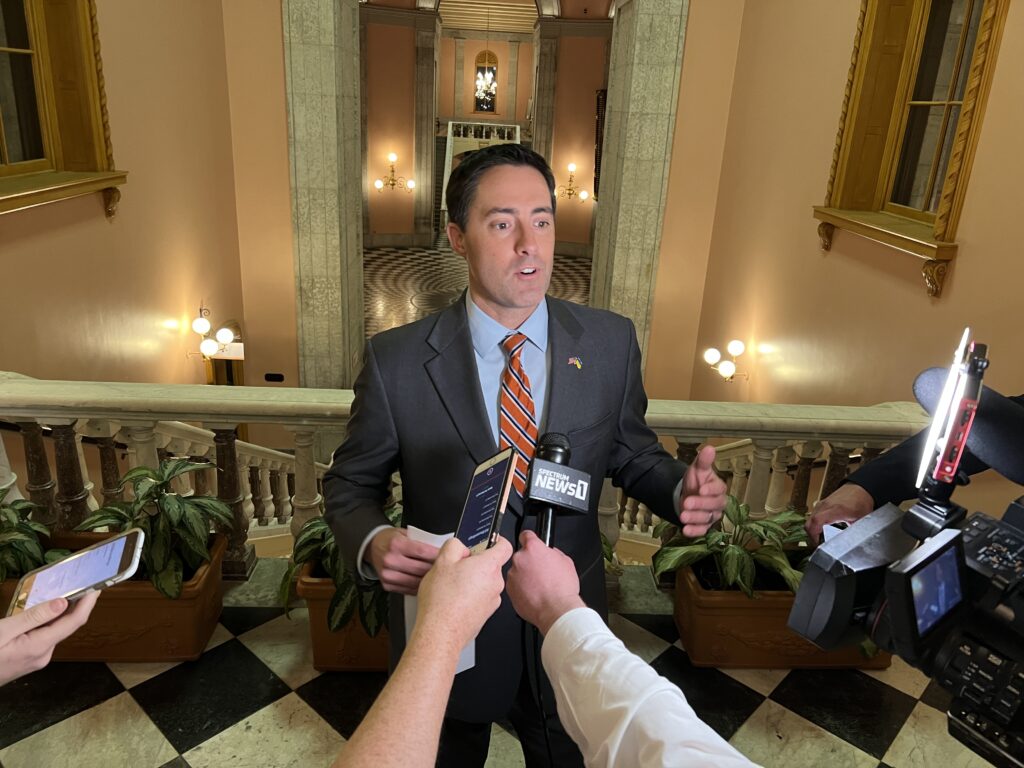
Ohio Secretary of State Frank LaRose talks to reporters. (Photo by Susan Tebben, OCJ.)
In a final message ahead of Election Day, Ohio Secretary of State Frank LaRose reminded voters about basic procedures like bringing a photo ID and what to expect as returns begin rolling in on Tuesday night.
Despite holding the briefing to keep voters informed, LaRose refused to allow the Ohio Capital Journal to attend in person. This story was reported via an Ohio Channel livestream.
Election Night reporting
LaRose said the state “will report 100% of our Election Day unofficial vote total,” but also warned the races too close to call won’t be settled until the official canvass three weeks later. He proposed a hypothetical race in which one candidate held a 60,000 vote lead but there were 300,000 outstanding absentee or provisional ballots.
“By definition, that race is not over,” LaRose insisted. “Numerically speaking, there are still enough votes that could change the result of that election. And so it’s important that we report that properly, that Ohioans understand how that works.”
According to the tally on Ohio’s early vote dashboard, there are more than 152,000 outstanding absentee ballots. If a race is too close to call, LaRose said, “it is going to be a wait before we can release the results. That’s not us delaying or waiting arbitrarily, it’s us following the law.”
It’s an important warning because in recent elections former President Donald Trump and his supporters have seized on delays to make allegations of fraud.
Center for Election Innovation and Research Executive Director David Becker explained while Trump wanted to “stop the count” in Pennsylvania last presidential election because he was ahead, he wanted officials to keep counting in Arizona where he trailed.
“I think we should expect to hear especially from former President Trump, since he’s done this before, that where he’s behind, he’ll say, continue the count, and where he’s ahead, he’ll say, stop the count,” Becker said. “But that’s not how it works. We have a total number of ballots, and we don’t stop until we count all of the ballots.”
As for the chances of some county election officials delaying certification over real or perceived fraud, LaRose downplayed the possibility.
“If there were some,” LaRose said, “and to be clear, there are not — I go to dozens of boards of elections every month, I’ve been all over the state visiting boards, I’ve heard no inclination whatsoever that anybody would be even thinking about that — but if they would, then again, there are legal remedies to compel public officials to do their job.”
LaRose noted as well that the first wave of results will be made up of absentee ballots — both those cast early in person and those sent through the mail or returned to drop boxes. It’s a provision that makes processing results far quicker on election night, and that officials in battleground states like Pennsylvania had urged their lawmakers to put in place. Pennsylvania state lawmakers didn’t take them up on that.
Election Day procedures
Polls will open on Election Day at 6:30 in the morning and close at 7:30 at night. As always, if people are in line when the polls officially close, they’ll still be allowed to vote so they should not leave line.
LaRose took a victory lap after winning a handful of voting related legal challenges. Voting rights groups took him to court arguing recent policy changes could make voting harder for those helping family members and recently naturalized citizens.
In both cases, the court allowed LaRose’s changes to remain in place.
The secretary also warned voters not to wear clothing at a polling location that could be perceived as advocating one candidate or another. State law prohibits campaigning at a polling location, and county boards sought guidance from the secretary on where to draw the line.
LaRose explained clothing with a candidate’s name or statements like “vote for” or “vote against” are clearly out of bounds. But a voter showing up in a T-shirt with the local high school’s mascot on it doesn’t amount to campaigning for a levy: “That’s getting ridiculous, right?”
All the same, he argued, some clothing makes a clear statement even if it’s indirect. He pointed to people at showing up at GOP campaign events over the weekend in garbage bags or reflective vests related to various “garbage” comments in the news last week.
But LaRose said election workers are not interested in “creating a scene.”
“So, if somebody insists on wearing that clothing, we’re going to write their name down, turn it over to the county board of elections — which could choose to pursue prosecution because it is a crime — but we’re not going to keep that person from voting, certainly.”
“They’re going to cast their ballot,” he went on, “they’re going to get their ‘I Voted’ sticker, and they’re going to be on their way.”
YOU MAKE OUR WORK POSSIBLE.

